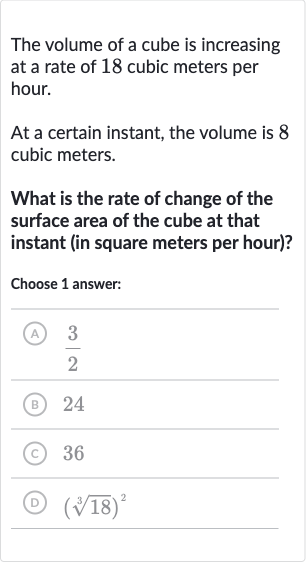AI tutor
Welcome to Bytelearn!
Let’s check out your problem:

The volume of a cube is increasing at a rate of cubic meters per hour.At a certain instant, the volume is cubic meters.What is the rate of change of the surface area of the cube at that instant (in square meters per hour)?Choose answer:(A) (B) (C) (D)
Full solution
Q. The volume of a cube is increasing at a rate of cubic meters per hour.At a certain instant, the volume is cubic meters.What is the rate of change of the surface area of the cube at that instant (in square meters per hour)?Choose answer:(A) (B) (C) (D)
- Find side length: First, find the side length of the cube when the volume is cubic meters. The formula for the volume of a cube is , where is the side length.
- Calculate side length: Calculate the side length: . So, , which is meters.
- Find surface area: Now, find the surface area of the cube using the side length. The formula for the surface area of a cube is .
- Calculate surface area: Calculate the surface area: square meters.
- Find rate of change: Next, find the rate of change of the side length as the volume increases. The formula for the volume of a cube is , so , where is the rate of change of volume and is the rate of change of the side length.
- Calculate rate of change: Plug in the known values: . So, , which means meters per hour.
- Find rate of change: Finally, find the rate of change of the surface area. The formula for the surface area of a cube is , so
- Calculate rate of change: Plug in the known values: . So, square meters per hour.
- Final answer: The correct answer is (C) square meters per hour.
More problems from Area of quadrilaterals and triangles: word problems
QuestionGet tutor help
QuestionGet tutor help
QuestionGet tutor help
QuestionGet tutor help
QuestionGet tutor help
QuestionGet tutor help
QuestionGet tutor help
